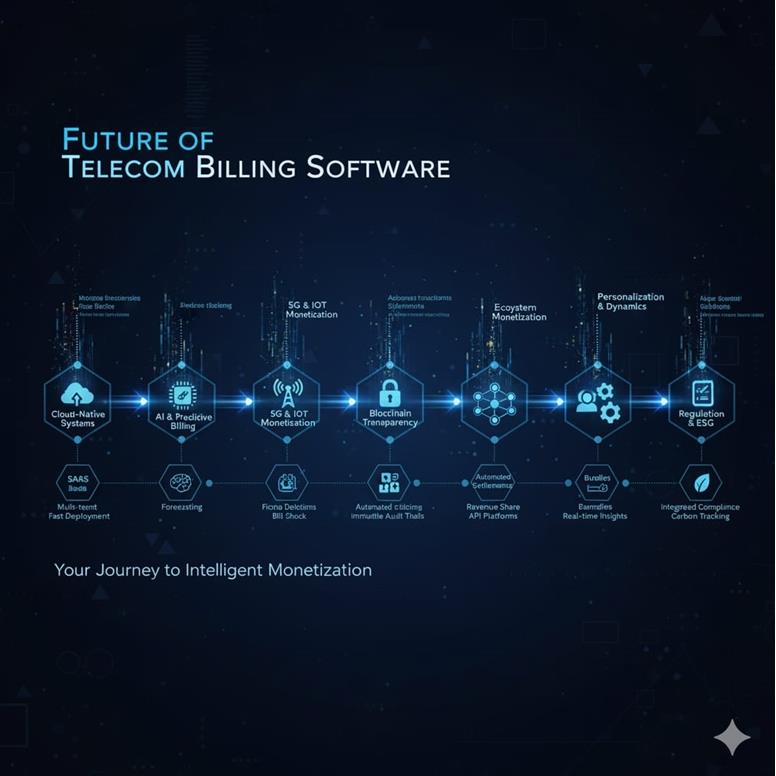
Earnbill Unveils Future Trends In Telecom Billing: What's Next For Billing Software

Before understanding the expected changes in the coming years for telecom billing software, let's understand how Telecom Billing Systems have evolved so far.
Legacy Systems (Pre-2000s)
Manual & Batch Processing: Billing was periodic, and there was one flat price for the plan.
Less Flexible: With very little or no capability for value-added offerings, it was essentially voice.
Maintenance: These were custom-built systems and thus difficult to upgrade.
Converged Billing (2000s-2010s)
Integrates Voice, Data, SMS: During this era, converged billing/charging emerged as the ability to bill for prepaid and postpaid.
Better Automation: Improved processing of CDRs led to better efficiencies in the systems.
Begin to look at CRM and ERP: Significantly improve customer experiences, but mostly segregated systems.
Digital Transformation Era (2010s-Early 2020s)
Real-time Charging: New real-time charging systems allowed for much more updated pricing, flexibility, better customer experiences, and propositions on fraud.
Cloud Begins: Operators began the transitional period from on-prem solutions to cloud solutions.
Customer-centric billing: Wished-for options such as self-service portals and apps, and promotions at their fingertips.
What to Expect in the Future
1. Fully Cloud-Native Billing Systems
Expect fully scalable cloud billing systems to provide BP, flexibility, and a lower total cost of ownership (TCO).
Expect:
-
SaaS-based billing systems.
Multi-tenant architectures.
Faster time to deploy.
2. AI and Predictive Billing
-
Increase accuracy and support better decisions.
The Predictive usage forecasting and churn analysis for AI-guided choices.
Smart bill shock detection and avoidance.
Fraud alerting and detection for anomalies in real-time.
3. Support for 5G and IoT monetization
New use cases involving ultra-low latency, massive device connections.
Expect:
-
Micro-transaction billing to arms-length.
Billing for Network Slicing.
Billing for QoS (quality of service) levels.
4. Blockchain billing for transparency
Better trust, traceability, and accuracy when settling with partners.
Expect:
-
Smart contracts for B2B and roaming agreements.
Immutable audit trails for compliance reasons.
5. Ecosystem and partner monetization
The proliferation of MVNOs, content providers, and edge computing
Expect:
-
Automated settlements to partners.
Revenue share engines.
API first monetization platforms.
6. Maximum personalization and pricing dynamics
Consumers want a billing user experience similar to the one from Netflix.
Expect:
-
Bundles and billing plans on a personalized level.
Loyalty and pricing based on gamification.
Provision deployment with immediate real-time insights into user interactions.
7. Supply chain regulation and ESG
Operators will require new sets of tools to meet rigid compliance and sustainability reporting standards.
Expect:
-
Integrated tools for tax, GDPR, and ESG reporting.
Carbon tracking feasibility incorporated into usage-based charging functions.

Legal Disclaimer:
MENAFN provides the
information “as is” without warranty of any kind. We do not accept
any responsibility or liability for the accuracy, content, images,
videos, licenses, completeness, legality, or reliability of the information
contained in this article. If you have any complaints or copyright
issues related to this article, kindly contact the provider above.
Most popular stories
Market Research

- Crypto Market Update: Pepeto Advances Presale With Staking Rewards And Live Exchange Demo
- Kucoin Appeals FINTRAC Decision, Reaffirms Commitment To Compliance
- Cregis And Sumsub Host Web3 Compliance And Trust Summit In Singapore
- Chartis Research And Metrika Release Comprehensive Framework For Managing Digital Asset Risk
- Nodepay Launches Crypto's Largest Prediction Intelligence Platform
- Schoenherr Opens London Liaison Office As Gateway To Central Eastern Europe



















Comments
No comment